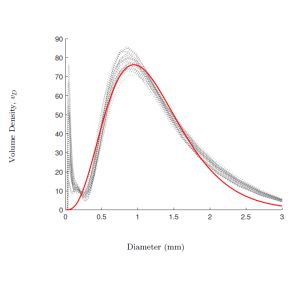Have you ever forgotten to replace the lid of the blender before beginning to puree your mango and passion-fruit smoothie? If you have, you'll have witnessed the catastrophic explosion of fruit and yoghurt flung haphazardly around the kitchen in an unpredictable manner. This is a consequence of the complicated and turbulent fluid dynamics present within the machine, the exact behaviour of which is unknown. Sharp, angular blades rotate at extremely high speeds to mix and chop the fruit into a puree consisting of particles that are ideally as small and uniform in size as possible. But what characteristics of the blender are responsible for the outcome? While experimental evidence gives intuition into blade and vessel design, along with operational parameters such as speed and blend time, there is a knowledge gap surrounding the precise impact on the particle and fluid dynamics.
Oxford Mathematicians Caoimhe Rooney, Ian Griffiths and Colin Please worked with Chuck Brunner, James Potter and Max Wood-Lee from SharkNinja, the company responsible for Nutri Ninja blenders, to understand the chopping dynamics that take place in a blender, with the aim of shedding light on this complex process.
The team derived an integro-differential-equation system, inspired by Becker-Döring and Smoluchowski theory, which provides a predictive model for the resulting size distribution of particles comprising a smoothie after blending an initial mixture of fruits (such as the contents of the blender shown in the figure) for a given amount of time.
The results of the model were found to agree well with experimental trials performed in house (see figure). An unexpected result was the emergence of a second peak in the size distribution of chopped pieces. This is attributed to the fact that each time the blade slices through a piece of fruit, some small debris is also formed. The team modified their model to account for this additional feature, which enabled the second peak to be predicted.
The taste and texture of a smoothie is heavily dependent on the size and distribution of the pieces from which it is composed. Given an initial selection of fruit pieces, along with the blend time and blend speed, the model is able to predict how the distribution of particle sizes and the most common piece size changes with time during blending. This provides guidance on the optimal blend time to maximize the taste experience.
The work performed by the team forms a foundation for the exploration and optimization of food blenders. In particular, this work paves the way for understanding the complex interplay between fluid dynamics and chopping within a blender. Ultimately, these models will allow us to determine the precise operating regime that will create the most homogeneous smoothies in the most efficient manner.
---
For more information click here.
The images above feature the NutriNinja blender and a comparison between theoretical prediction (red) and experimental data (grey) for the distribution of different particle sizes in a blender after 50 seconds of blending.



